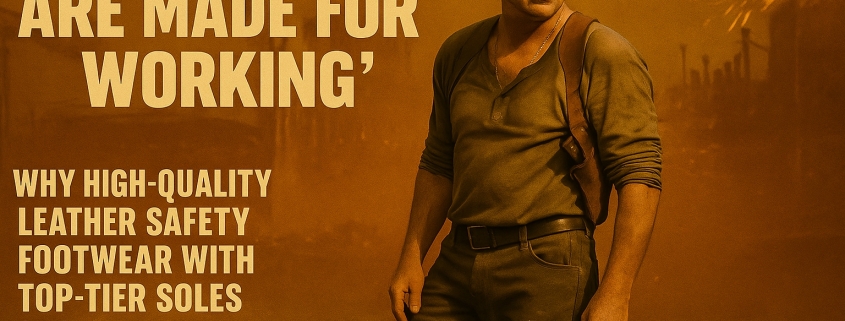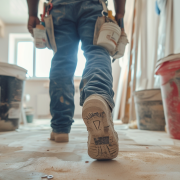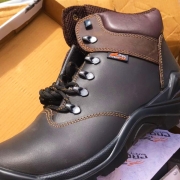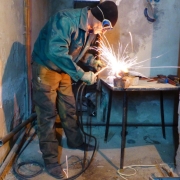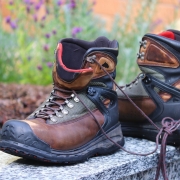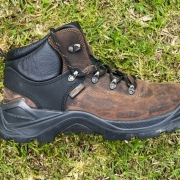These Boots Are Made for Working
Why High-Quality Leather Safety Footwear with Top-Tier Soles Should Be Your Only Choice
“You can’t step into the arena of hard work wearing budget boots and expect to walk out like John McClane in Die Hard.” – Probably Confucius, if he wore a pair of ProFit Safety boots.
CHAPTER ONE: THE FOOTWEAR APOCALYPSE
Let’s start with a scene.
You’re on-site. It’s cold, it’s wet, the concrete is unforgiving. Sparks are flying — both literal and metaphorical — and all around you is the thunder of productivity. Everyone’s got a job. Everyone’s got a pace. And you? You’ve just had your soul (and your sole) crushed by your R150 “safety” boots from the clearance bin at a street market.
Not even five weeks in and they’re cracking like the Ark of the Covenant in Raiders of the Lost Ark. The fake leather’s peeling, the steel toe’s rusting, and the rubber? Let’s just say it’s about as “durable” as wet tissue paper.
Meanwhile, that guy across from you — the one who walks like he owns the site, whose boots look like they’ve been through ten wars and still came out with swagger — he’s wearing the real deal. Full-grain leather. Precision stitching. Shock-absorbing polyurethane soles with heat resistance to boot (no pun intended). And while your feet are screaming “Why have you forsaken us?”, his feet are practically humming “Staying Alive” by the Bee Gees.
So here’s the bottom line: if your feet are your foundation — and spoiler alert, they are — then what you wear on them is not some afterthought. It’s the first thought.
Welcome to the gospel of proper safety boots.
CHAPTER TWO: LEATHER – NOT ALL HIDES ARE CREATED EQUAL
Let’s put the buffalo and cow back in the conversation. “Leather” is one of those words that sounds universally good. Like “organic” or “handcrafted” or “limited edition”. But don’t be fooled. There’s leather, and then there’s leather.
The Hall of Fame:
Full-Grain Leather – The Gandalf of leathers. Tough, wise, ages like a whiskey barrel. This is the unbuffed, uncorrected, unbothered version. It shows the real surface of the hide — scars, texture, natural grain. And that’s exactly what makes it superior. Stronger. Water-resistant. More breathable.
Top-Grain Leather – Slightly sanded down for a smoother finish but still a heavyweight champion. Not quite full-grain, but still worthy of a standing ovation. It can take punch – think of Iron Mike before Buster Douglas.
The Hall of Shame:
Genuine Action Leather – Ah yes, the world’s biggest misnomer. “Genuine” makes it sound authentic, but in truth, it’s the Frankenstein of leather. Compressed scraps glued together like some back-alley experiment. Not ideal unless your goal is foot rot and deep regret. The walk of shame.
Bonded Leather – Imagine if a handbag and a cardboard box had a terrible baby. That’s bonded leather. Avoid it like a rebooted Charlie’s Angels film.
If your work boots aren’t made from full-grain or top-grain leather, you’re not wearing protective gear — you’re just cosplaying as someone who does.
CHAPTER THREE: THE SOLE OF THE MATTER
Ah yes, the sole. Not to be confused with the thing your grandmother says is immortal. This sole is a whole different beast — and arguably the most important component in the architecture of a safety boot.
And let’s be clear: polyurethane and rubber soles are not created equal, and they certainly aren’t interchangeable with whatever knockoff foam hybrid your discount boots have going on.
Why Cheap Soles Are Foot Kryptonite:
– They crack. Early.
– They warp. Badly.
– They absorb water like a sponge at a beach party.
– And worst of all — they offer zero shock absorption. Jump off that third step like Kevin Bacon in Footloose at your peril.
– Cue the Law & Order: SVU sound effect: DUN-DUN.
Now Enter:
Top-Grade Polyurethane and Rubber
Let’s break it down like we’re teaching a physics class taught by Tony Stark:
Polyurethane (PU) – Light. Shock-absorbing. Slip-resistant. Flexible. This is the sports car of soles. Ideal for people on their feet 10+ hours a day, moving from gravel to scaffolding to lunch truck and back again. Double-density PU even gives you an inner core for comfort and outer shell for durability. Think Air Jordans in a Mad Max universe.
Rubber Soles – The Marvel Hulk. Heavier. Bulkier. But indestructible. Great for heat resistance (some up to 300°C), chemical protection, and slip hazards. Ideal for welding, oil rigs, or anywhere the floor wants to kill you.
And the best boots? They combine them. PU midsoles for comfort, rubber outsoles for defense. It’s the Avengers-level team-up your feet deserve. Assemble!
CHAPTER FOUR: POP CULTURE COMPARISONS (FOR SCIENCE)
Let’s take a detour for the nerds, the cinephiles, and the curious. Imagine these boots were action heroes.
– Cheap Boots = Adam Sandler in Jack & Jill. Unintentionally hilarious, wildly unstable, falls apart on impact. Unlike Arnold… you won’t be back.
– Top-Grade PU Boots = Jason Bourne. Smart, light, precise. Never loses his footing. Can take a hit and still sprint across a rooftop.
– High-Quality Rubber Boots = John Wick. Unflinching. Bulletproof. The kind of force you don’t mess with — especially when it comes to fire, oil, or tactical scenarios.
In the world of work boots, you don’t want to be in a slapstick comedy. You want to star in a rugged, no-nonsense thriller where your footwear is your co-star, not the villain.
CHAPTER FIVE: THE PRICE LIE
Here’s the con: people look at premium safety footwear and balk at the price. “R800 for safety boots? I could buy three pairs for that!” And sure, you could. You could also buy three paper umbrellas and wear them as hats. Doesn’t mean it’s smart.
Because here’s the actual math:
Cheap boots last maybe 3 months. Then you replace them.
High-quality boots? Easily 2 years with proper care.
Add to that the reduction in back pain, blisters, foot fatigue, and you’re not just paying for boots — you’re buying performance enhancement. Think of it as a legal steroid for your entire shift.
It’s the same reason James Bond doesn’t wear knockoff Oxfords. When the mission matters, your kit matters.
CHAPTER SIX: FEATURES YOU DIDN’T KNOW YOU NEEDED
The holy trinity of safety boots goes well beyond just “steel toe and black.” Let’s talk upgrades:
– Composite Toes and Anti Puncture Material (Kevlar) Midsoles– Just as protective as steel but lighter and won’t set off airport scanners. Also, they don’t conduct heat or cold. It’s like upgrading from VHS to Netflix.
– Metatarsal Guards – Protect the top of your foot from falling objects. Useful if you work anywhere where gravity is your sworn enemy.
– EH! (Non Conductive and Insulated Ratings) – That’s electrical hazard protection, not a Canadian greeting. If you’re around live wires, this could save your literal life.
– Heat/Slip/Chemical Resistance – Because one oil slick shouldn’t send you flying like a Looney Tunes character.
– Moisture Wicking and Sports Mesh Liners – For the guy who sweats like he’s inside a sauna but who still wants socks drier than a Tarantino monologue.
CHAPTER SEVEN: CRAFTSMANSHIP – WHY CONSTRUCTION MATTERS
Let’s talk build. Real safety boots are constructed, not “assembled in a sweatshop by ghosts and duct tape.”
Look for:
– Direct Injected Construction – Gives your sole durability, and offers mind-blowing flexibility with light weight feel. A sign that someone knew what they were doing when they made your boots.
– Double & Triple Stitching – Single stitching is fine. Double & Triple stitching? That’s a company saying, “This won’t fall apart — even if you do.”
– Padded Collars and Breathable Lining – Yes, your boots should feel like a cocoon and not a concrete coffin.
– Ankle Support – Because one rolled ankle is all it takes to transform a productive day into a Netflix marathon in a hospital bed.
CHAPTER EIGHT: YOU’RE NOT JUST A WORKER — YOU’RE A WARRIOR
This is your gladiator arena. Your Batcave. Your Millennium Falcon. You don’t go into battle with subpar gear — you suit up with armor that means something.
Boots aren’t an accessory. They’re a foundational tool. Like Thor’s hammer, Indy’s whip, or Ripley’s exosuit. They’re the unsung hero of every hard-fought hour on-site. The difference between fatigue and performance. Between injury and longevity. Between “good enough” and built for life.
FINAL CHAPTER: THE FOOTWEAR MANIFESTO
So here it is. Your declaration. Your line in the concrete.
– Thou shalt not buy cheap boots.
– Thou shalt invest in full-grain leather.
– Thou shalt worship the gospel of premium polyurethane and blessed rubber soles.
– Thou shalt reject mediocrity from heel to toe.
Because at the end of the day, when the dust settles and the tools are down — you’ll still be standing tall, with feet that thank you. And let’s face it: in a world full of shortcuts, choosing quality leather safety footwear isn’t just the right move.
It’s the only move.
